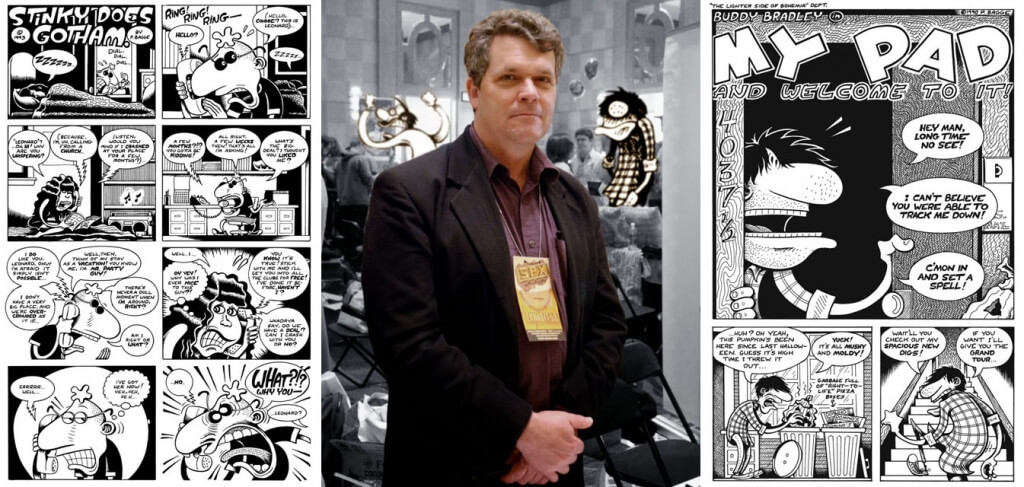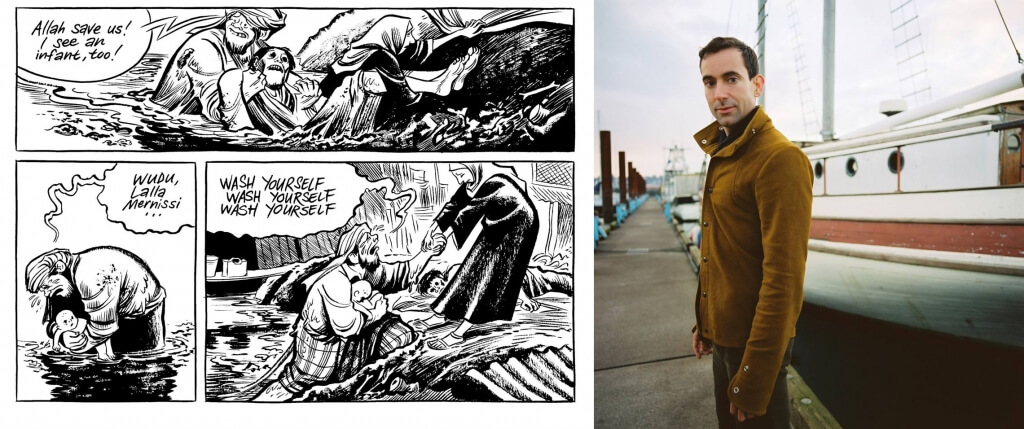With numerous breakout bestsellers and esteemed awards between them, Peter Bagge, Craig Thompson and Ben Hatke are three of the greatest graphic novelists of today. Here, we chat with them about everything from superpowers and childhood dreams, to the challenges of creating a captivating graphic novel.
What was your childhood ambition?
Peter Bagge: Baseball player, rock star or cartoonist where my main dream jobs. At least I made one of them work! I also always liked any job that involved driving a truck: garbage man, milkman etc. I still fantasise about driving for FedEx on occasion!

[Photo and artwork: Peter Bagge]
Ambition or talent: Which matters more to success as a cartoonist?
Craig Thompson: Definitely ambition, drive, discipline. A combination of being no-nonsense about a regular drawing routine, along with being open, flexible, experimental. Talent, as they say in any medium, is overrated.
Where do you get the inspiration for your artwork?
Ben Hatke: Just everywhere, really. What I often find myself doing is telling stories that include fantastic elements from the books I’ve loved – robots and dragons, for instance – and combining those elements with the world of my backyard. That seems to work very well. My family splits time between our home in the Shenandoah Valley of Virginia and a family home in the Apennine mountains of Italy. Both of those landscapes feature prominently in my work.
Do you see yourself in any of your characters?
Peter Bagge: Of course. All my protagonists are extensions of myself to some extent.
Craig Thompson: Yes, in all of them. Even the deplorable ones reflect some facet of my personality. Lately I feel like the poor fisherman in Habibi named Noah, who dredged garbage out of polluted water every day with an optimistic attitude, until one day he just snapped, searching for stories to replenish his spirit.

[Photo and artwork: Craig Thompson]
What would you say is the biggest challenge when creating a graphic novel?
Ben Hatke: Honestly, the biggest challenge is just telling a good story. With each successive project, I find myself spending more and more time in the outlining phase, nailing down the beats of the story before I ever start drawing.
Comics is a very strange medium. At its best it’s like being able to make a movie with an unlimited budget. You want something to explode? You just draw it! You want your main character to transform into a tiger made of gummy bears? If you can imagine it, you can probably draw it! But no matter what your special effects budget is, and no matter how well you draw, the audience is there for a good story – and if they don’t get that, they will feel cheated.
So my goal, and my central challenge, is to create characters that my readers will care for, to put those characters through their paces, and then bring them (both the characters and the readers) to an ending that feels resonant. A good ending should feel both surprising and inevitable. Story. Story is king.
What role do you believe the cartoonist has in society as an artist?
Peter Bagge: To make quality art, and to express themselves freely and honestly.
Craig Thompson: Cartooning is a humble, working-class discipline. It’s not isolated from the public sphere and inaccessible to the masses like a lot of contemporary art. And it’s rarely as commercial as the entertainment arts. It’s intimate and personal, like old-fashioned letter writing. One person, with just paper and pen, can create a graphic novel, and it’s generally best that way.
Ben Hatke: I tend to think that the calling of the artists, at its best, is to look deep, ponder long, and then make and share things. Beautiful things, scary things, simple things and complicated things. Comics are just another medium, but an immensely powerful medium. Comics transcend language. When you get on an airplane, there’s a little comic in your seat back that tells you what to do in an emergency. But there are also comics that are haunting war memoirs, coming-of-age stories, or biographies of great physicists. And there are comics that tell stories about a duck that swims in a huge vault of money. It’s the accessibility of comics that gives the medium its power.
If you could only read one graphic novel for the rest of your life (other than your own work) which would you pick?
Peter Bagge: That’s a tough one! If I could pick a collection of shorter works, it’d be the Smithsonian Collection of American Comic Book Art.
Craig Thompson: Probably Hicksville by the New Zealand cartoonist Dylan Horrocks. It’s about the unrealised potential of the comics medium, but broader than that, the unrealised potential of the human spirit, leaving and returning to your homeland, and trying to tend to neglected gardens and neglected relationships. It resonates with me at every age, whether I’m striving or failing in my life.
If you could have any superpower, would you want it to be?
Peter Bagge: The power to see the future, I suppose. But I wonder if that might make my head explode. I doubt that the human mind could handle such a “power”.
Craig Thompson: It’s generic and obvious, but certainly FLYING. For the thrill, for the convenient transportation, for the change in perspective that I constantly need.
Ben Hatke: I’ve thought about this one a lot! I think the ultimate superpower would be to know, once a day, exactly when and where something horrible was going to happen. Think about it! In real life, superheroes would spend hours and hours on patrol, hoping to happen upon a crime. The real magic is showing up just when you’re needed. In a costume.

[Photo and artwork: Ben Hatke]
Ben Hatke is the writer and illustrator behind the New York Times bestselling Zita the Spacegirl trilogy, the picture books Julia’s House for Lost Creatures, and the graphic novels Little Robot and Mighty Jack. Visit benhatke.com.
Craig Thompson, winner of four Harvey Awards, three Eisner Awards and two Ignatz Awards, is one of the most successful graphic novelists of today. His works include Blankets (Time’s #1 graphic novel for 2003), Carnet de Voyage and Habibi, among others. Visit his blog at dootdootgarden.com.
Peter Bagge, famous for his black humour and decadent but hilarious heroes, is the legendary cartoonist behind such classics as Neat Stuff and Hate. Boasting two Harvey Awards and millions of copies sold globally, Bagge is often hailed as a comedy comic genius. Visit peterbagge.com.














Sorry, the comment form is closed at this time.